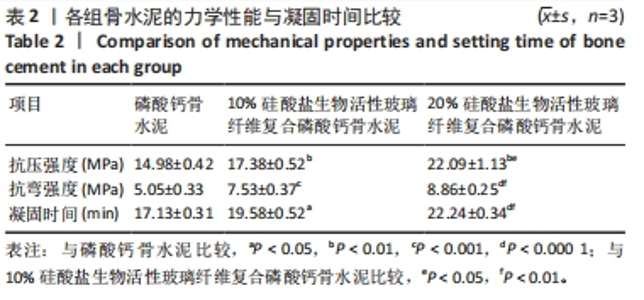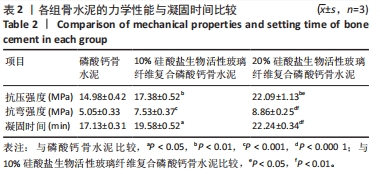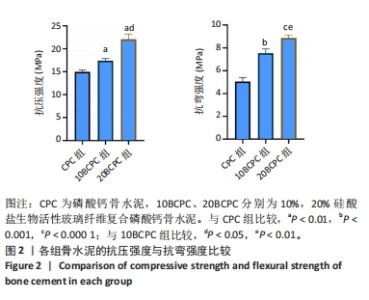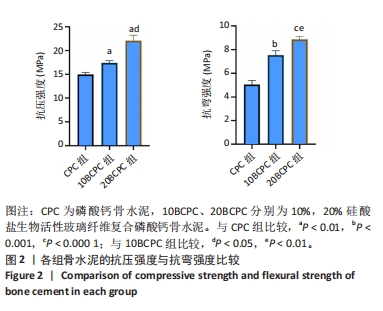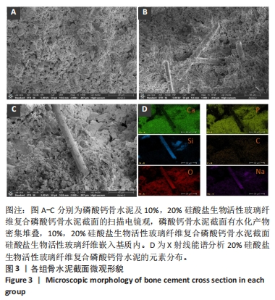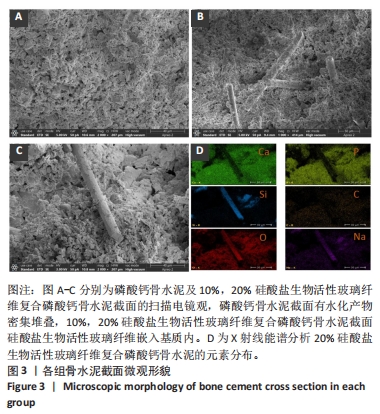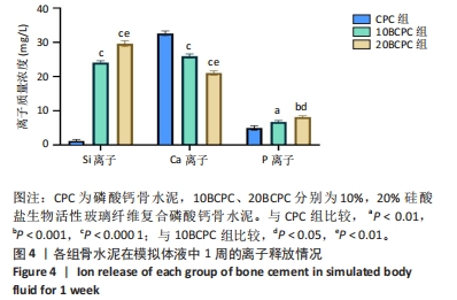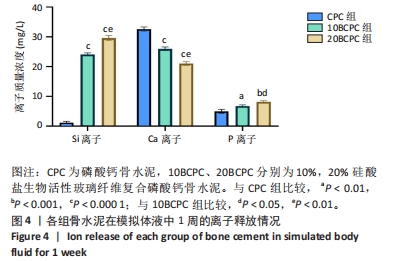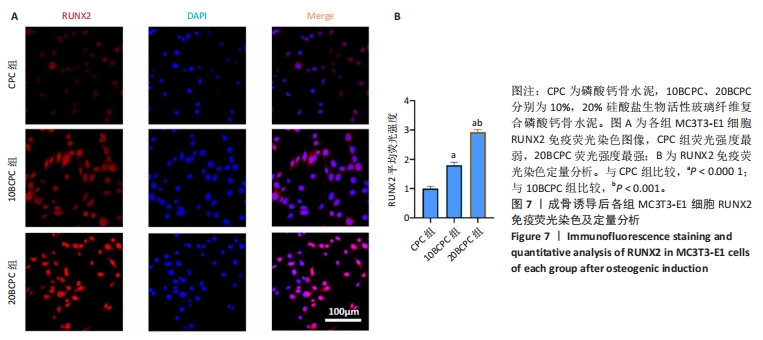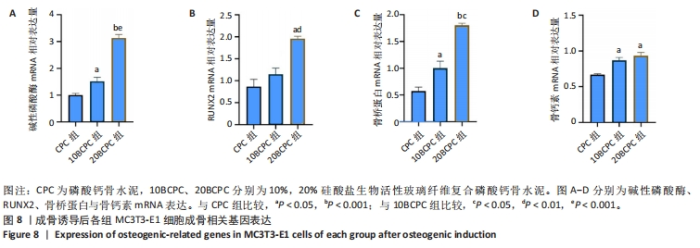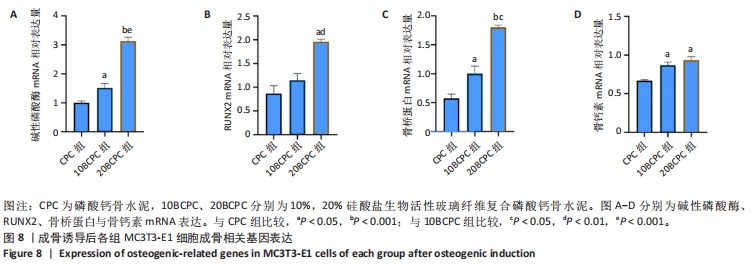Chinese Journal of Tissue Engineering Research ›› 2025, Vol. 29 ›› Issue (28): 5994-6002.doi: 10.12307/2025.473
Previous Articles Next Articles
Effect of silicate bioactive glass fiber on properties of calcium phosphate bone cement
Lu Yuzheng1, 2, Xiong Yingjie2, Shan Yanbo2, Ye Jianting2, Wu Yanbin2, Song Jipeng1, Zhang Yao1, 2, Lin Wancheng1, 2, Weng Qirui2, Cheng Xuan2, Meng Haoye2, Xu Wenjing2, Peng Jiang2, Ding Lixiang1
- 1Beijing Shijitan Hospital, Capital Medical University, Beijing 100038, China; 2Research Institute of Orthopedic Medicine Department of Fourth Medical Center of Chinese PLA General Hospital, Beijing 100853, China
-
Received:2024-04-15Accepted:2024-07-06Online:2025-10-08Published:2024-12-07 -
Contact:Peng Jiang, PhD, Professor, Research Institute of Orthopedic Medicine Department of Fourth Medical Center of Chinese PLA General Hospital, Beijing 100853, China Ding Lixiang, PhD, Professor, Beijing Shijitan Hospital, Capital Medical University, Beijing 100038, China -
About author:Lu Yuzheng, Doctoral candidate, Physician, Beijing Shijitan Hospital, Capital Medical University, Beijing 100038, China; Research Institute of Orthopedic Medicine Department of Fourth Medical Center of Chinese PLA General Hospital, Beijing 100853, China -
Supported by:Beijing-Tianjin-Hebei Basic Research Cooperation Special Project, No. 22JCZXJC00130 (to XWJ)
CLC Number:
Cite this article
Lu Yuzheng, Xiong Yingjie, Shan Yanbo, Ye Jianting, Wu Yanbin, Song Jipeng, Zhang Yao, Lin Wancheng, Weng Qirui, Cheng Xuan, Meng Haoye, Xu Wenjing, Peng Jiang, Ding Lixiang. Effect of silicate bioactive glass fiber on properties of calcium phosphate bone cement[J]. Chinese Journal of Tissue Engineering Research, 2025, 29(28): 5994-6002.
share this article
Add to citation manager EndNote|Reference Manager|ProCite|BibTeX|RefWorks
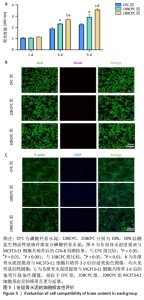
2.5 各组骨水泥的细胞相容性 CCK-8检测结果显示,培养1 d,3组间细胞增殖比较差异无显著性意义(P > 0.05);培养3,5 d,10%,20%硅酸盐生物活性玻璃纤维复合磷酸钙骨水泥组细胞增殖快于磷酸钙骨水泥组(P < 0.05,P < 0.01,P < 0.001),20%硅酸盐生物活性玻璃纤维复合磷酸钙骨水泥组细胞增殖快于10%硅酸盐生物活性玻璃纤维复合磷酸钙骨水泥组(P < 0.05,P < 0.01),见图5A。 活死染色结果显示3组均未见到明显死细胞,表明3组骨水泥无细胞毒性,见图5B。鬼笔环肽染色结果显示,相较于磷酸钙骨水泥组,10%,20%硅酸盐生物活性玻璃纤维复合磷酸钙骨水泥组MC3T3-E1细胞形态呈纺锤形且更为延展,见图5C。"
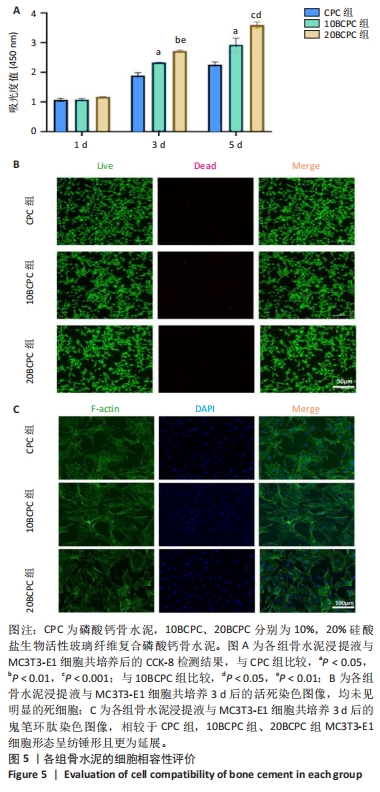
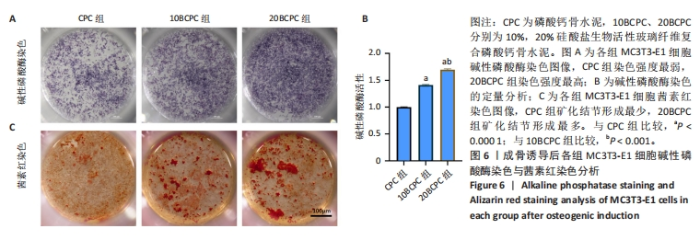
2.6 各组骨水泥的体外成骨诱导性能 2.6.1 碱性磷酸酶染色及定量分析 碱性磷酸酶染色结果显示,10%,20%硅酸盐生物活性玻璃纤维复合磷酸钙骨水泥组碱性磷酸酶染色深度明显强于磷酸钙骨水泥组,并且以20%硅酸盐生物活性玻璃纤维复合磷酸钙骨水泥组染色深度最强;定量分析结果显示,10%,20%硅酸盐生物活性玻璃纤维复合磷酸钙骨水泥组碱性磷酸酶活性高于磷酸钙骨水泥组(P < 0.000 1),20%硅酸盐生物活性玻璃纤维复合磷酸钙骨水泥组碱性磷酸酶活性高于10%硅酸盐生物活性玻璃纤维复合磷酸钙骨水泥组(P < 0.001),见图6A,B。 2.6.2 茜素红染色 茜素红染色结果显示,磷酸钙骨水泥组及10%,20%硅酸盐生物活性玻璃纤维复合磷酸钙骨水泥组矿化结节形成依次增加,见图6C,表明了材料诱导的晚期细胞外钙沉积。"
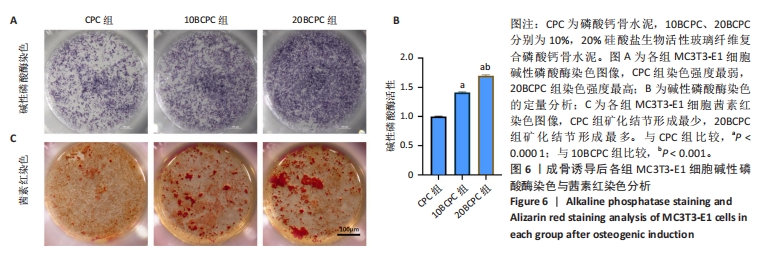
| [1] LODOSO-TORRECILLA I, BEUCKEN JJJP, JANSEN JA. Calcium phosphate cements: Optimization toward biodegradability. Elsevier. 2021;119: 1-12. [2] GOLDBERG MA, KROHICHEVA PA, FOMIN AS, et al. In situ magnesium calcium phosphate cements formation: From one pot powders precursors synthesis to in vitro investigations. Bioact Mater. 2020; 5(3):644-658. [3] ZHONG WB, SUN L, YU T, et al. Preparation and characterization of calcium phosphate cement with enhanced tissue adhesion for bone defect repair. Ceram Int. 2021;47(2):1712-1720. [4] MD DALI SS, WONG SK, CHIN KY, et al. The Osteogenic Properties of Calcium Phosphate Cement Doped with Synthetic Materials: A Structured Narrative Review of Preclinical Evidence. Int J Mol Sci. 2023;24(8):7161. [5] HENCH LL, POLAK JM. Third-Generation Biomedical Materials. Science (New York, NY). 2002;295(5557):1014-1017. [6] WU ZF, LIN ZY, YAO AH, et al. Influence of particle size distribution on the rheological properties and mathematical model fitting of injectable borosilicate bioactive glass bone cement. Ceram Int. 2020;46(15):1-12. [7] RIZWAN M, HAMDI M, BASIRUN WJ. Bioglass® 45S5-based composites for bone tissue engineering and functional applications. J Biomed Mater Res Part A. 2017;105(11):3197-3223. [8] PAKNAHAD A, GOUDARZI M, KUCKO NW, et al. Calcium phosphate cement reinforced with poly (vinyl alcohol) fibers: An experimental and numerical failure analysis. Acta Biomater. 2021;119:458-471. [9] 熊英杰,叶健廷,王鹏,等.可注射型磷酸镁自固化骨水泥修复大鼠股骨髁骨缺损的实验研究[J]. 解放军医学院学报,2023,44(6): 655-661. [10] HABRAKEN WJ, WOLKE JG, JANSEN JA. Ceramic composites as matrices and scaffolds for drug delivery in tissue engineering. Adv Drug Delivery Rev. 2007;59(4-5):234-248. [11] SCHICKERT SL, JANSEN JA, BRONKHORST EM, et al. Stabilizing dental implants with a fiber-reinforced calcium phosphate cement: An in vitro and in vivo study. Acta Biomater. 2020;110:280-288. [12] ZANDI KARIMI A, REZABEIGI E, DREW RAL. Glass ionomer cements with enhanced mechanical and remineralizing properties containing 45S5 bioglass-ceramic particles. J Mech Behav Biomed Mater. 2019;97: 396-405. [13] KRÜGER R, GROLL J. Fiber reinforced calcium phosphate cements -- on the way to degradable load bearing bone substitutes? Biomaterials. 2012;33(25):5887-5900. [14] SHUAI C, ZHOU J, WU P, et al. Enhanced Stability of Calcium Sulfate Scaffolds with 45S5 Bioglass for Bone Repair. Materials (Basel, Switzerland). 2015;8(11):7498-7510. [15] LIANG T, GAO CX, YANG L, et al. Deterioration of the mechanical properties of calcium phosphate cements with Poly (γ-glutamic acid) and its strontium salt after in vitro degradation. J Mech Behav Biomed. 2017;75:190-196. [16] FILIP DG, SURDU VA, PADURARU AV, et al. Current Development in Biomaterials-Hydroxyapatite and Bioglass for Applications in Biomedical Field: A Review. J Funct Biomater. 2022;13(4):248. [17] SHIKIMAKA O, BIVOL M, SAVA BA, et al. Hydroxyapatite-bioglass nanocomposites: Structural, mechanical, and biological aspects. Beilstein J Nanotechnol. 2022;13:1490-1504. [18] YU L, LI Y, ZHAO K, et al. A novel injectable calcium phosphate cement-bioactive glass composite for bone regeneration. PLoS One. 2013;8(4):e62570. [19] HENCH LL. Bioceramics: From Concept to Clinic. J Am Ceram Soc. 1991;74(7):1487-1510. [20] VAN VUGT TA, GEURTS JAP, ARTS JJ, et al. Biomaterials in treatment of orthopedic infections. Management of periprosthetic joint infections (PJIs),2016. [21] LIN CC, LEUNG KS, SHEN P, et al. Elasticity and structure of the compounds in the wollastonite (CaSiO3)-Na2SiO3 system: from amorphous to crystalline state. J Mater Sci Mater Med. 2015;26(1): 5361. [22] KAIMONOV MR, SAFRONOVA TV. Materials in the Na2O-CaO-SiO2-P2O5 System for Medical Applications. Materials (Basel). 2023; 16(17):5981. [23] AXRAP A, WANG J, LIU Y, et al. Study on adhesion, proliferation and differentiation of osteoblasts promoted by new absorbable bioactive glass injection in vitro. Eur Rev Med Pharmacol Sci. 2016;20(22): 4677-4681. [24] SÖHLING N, AL ZOGHOOL S, SCHÄTZLEIN E, et al. In vitro Evaluation of a 20% Bioglass-Containing 3D printable PLA Composite for Bone Tissue Engineering. Int J Bioprint. 2022;8(4):602. [25] KANG MS, LEE NH, SINGH RK, et al. Nanocements produced from mesoporous bioactive glass nanoparticles. Biomaterials. 2018;162: 183-199. [26] PISHBIN F, MOURIÑO V, FLOR S, et al. Electrophoretic deposition of gentamicin-loaded bioactive glass/chitosan composite coatings for orthopaedic implants. ACS Appl Mater Interfaces. 2014;6(11): 8796-8806. [27] ZHOU Y, WANG D, YANG Y. Biodegradation and Cell Behavior of a Mg-Based Composite with Mesoporous Bioglass. Materials (Basel). 2023;16(18):6248. [28] ZHENG X, LIU Y, LIU Y, et al. Novel three-dimensional bioglass functionalized gelatin nanofibrous scaffolds for bone regeneration. J Biomed Mater Res B. 2021;109(4):517-526. [29] MANOOCHEHRI H, GHORBANI M, MOOSAZADEH MOGHADDAM M, et al. Strontium doped bioglass incorporated hydrogel-based scaffold for amplified bone tissue regeneration. Sci Rep. 2022;12(1):10160. [30] FERREIRA SA, YOUNG G, JONES JR, et al. Bioglass/carbonate apatite/collagen composite scaffold dissolution products promote human osteoblast differentiation. Mat Sci Eng C-Mater. 2021;118:111393. [31] SADIASA A, SARKAR SK, FRANCO RA, et al. Bioactive glass incorporation in calcium phosphate cement-based injectable bone substitute for improved in vitro biocompatibility and in vivo bone regeneration. J Biomater Appl. 2014;28(5):739-756. [32] HASAN ML, KIM B, PADALHIN AR, et al. In vitro and in vivo evaluation of bioglass microspheres incorporated brushite cement for bone regeneration. Mat Sci Eng C-Mater. 2019;103:109775. [33] ZHANG X, CHEN Y, FU J, et al. An injectable pH neutral bioactive glass-based bone cement with suitable bone regeneration ability. J Orthop Transl. 2022;36: 120-131. [34] TSIGKOU O, JONES JR, POLAK JM, et al. Differentiation of fetal osteoblasts and formation of mineralized bone nodules by 45S5 Bioglass conditioned medium in the absence of osteogenic supplements. Biomaterials. 2009;30(21):3542-3550. [35] 于龙.可注射生物玻璃-磷酸钙骨水泥复合生物材料的实验研究[D].西安:第四军医大学,2013. [36] TAN T, SONG D, HU S, et al. Structure and Properties of Bioactive Glass-Modified Calcium Phosphate/Calcium Sulfate Biphasic Porous Self-Curing Bone Repair Materials and Preliminary Research on Their Osteogenic Effect. Materials (Basel, Switzerland). 2022;15(22):7898. [37] WANG C, LIN K, CHANG J, et al. Osteogenesis and angiogenesis induced by porous β-CaSiO3/PDLGA composite scaffold via activation of AMPK/ERK1/2 and PI3K/Akt pathways. Biomaterials. 2013;34(1):64-77. [38] KARPOV M, LACZKA M, LEBOY PS, et al. Sol-gel bioactive glasses support both osteoblast and osteoclast formation from human bone marrow cells. J Biomed Mater Res A. 2008;84(3):718-726. [39] LOPES JH, SOUZA LP, DOMINGUES JA, et al. In vitro and in vivo osteogenic potential of niobium-doped 45S5 bioactive glass: A comparative study. J BIomed Mater Res B. 2020;108(4):1372-1387. |
| [1] | Cai Yaohao, Lang Lyu, Li Hong. Assessing the bone mass of the residual alveolar ridge in the first molar for implant placement by cone-beam computed tomography [J]. Chinese Journal of Tissue Engineering Research, 2025, 29(8): 1572-1577. |
| [2] | Liu Haoyang, Xie Qiang, Shen Mengran, Ren Yansong, Ma Jinhui, Wang Bailiang, Yue Debo, Wang Weiguo . Application, research hotspots, and shortcomings of degradable zinc-based alloys in bone defect repair and reconstruction [J]. Chinese Journal of Tissue Engineering Research, 2025, 29(4): 839-845. |
| [3] | Zhang Lichuang, Yang Wen, Ding Guangjiang, Li Peikun, Xiao Zhongyu, Chen Ying, Fang Xue, Zhang Teng. Dispersion effect of bone cement after vertebroplasty using individualized unilateral external pedicle approach and bilateral pedicle approach [J]. Chinese Journal of Tissue Engineering Research, 2025, 29(4): 800-808. |
| [4] | Zhou Yang, Liu Kexin, Wang Deli, Sun Zhang. Regenerative effects of engineered extracellular vesicles on repairing bone defects [J]. Chinese Journal of Tissue Engineering Research, 2025, 29(36): 7839-7847. |
| [5] | Wang Jingshuai, Zhang Xiaotong, Zhang Yange, Wan Zedong, Kong Lingwei, Cao Haiying, Jin Yu. Comparison of Mg-Li-Gd alloy and stainless steel intramedullary nail for fixation of femoral annular hemi-defects in rats [J]. Chinese Journal of Tissue Engineering Research, 2025, 29(34): 7261-7268. |
| [6] | Ren Bo, Tang Yongliang, Li Ni, Liu Bangding. Thermosensitive antibacterial hydrogel for treatment of infected bone defects [J]. Chinese Journal of Tissue Engineering Research, 2025, 29(34): 7269-7277. |
| [7] | Sheng Wenbo, Liu Bingli, Li Sibo, Ao Rongguang, Yu Baoqing. Cement-augmented short-segment percutaneous pedicle screw fixation for the stage II Kümmell’s disease [J]. Chinese Journal of Tissue Engineering Research, 2025, 29(34): 7286-7292. |
| [8] | Wu Ziwei, Luo Yicai, Wei Yinge, Liao Hongbing. Application of poly(lactic-co-glycolic acid) copolymer in stomatology [J]. Chinese Journal of Tissue Engineering Research, 2025, 29(34): 7393-7404. |
| [9] | Akliya·Anwar, Nafisa·Gupur, Baibugafu·Yelisi, Zilalai·Gulaiti, Guzalnur·Emrayim, Nijat·Tursun. Dynamic stress analysis of maxillary sinus lifting without bone grafting and with immediate loading after bone grafting [J]. Chinese Journal of Tissue Engineering Research, 2025, 29(30): 6416-6425. |
| [10] | Deng Guanghui, Xiang Wei, Su Qifan, Chen Xiaoyu, Wang Liangwei, Wan Zhihong, Wu Jiaqi, Chen Xiaojun. Preparation of osteoporotic femoral condylar bone defect model in rabbits and its critical value [J]. Chinese Journal of Tissue Engineering Research, 2025, 29(30): 6426-6433. |
| [11] | Zhao Xingcheng, Wang Jun, Lu Ming. Repair strategies for nonunion in old osteoporotic vertebral compression fractures: a case analysis [J]. Chinese Journal of Tissue Engineering Research, 2025, 29(3): 538-546. |
| [12] | Shen Zhen, Huang Ziyue, He Zhijuan, Wang Yiting, Chen Qigang, Geng Chunmei, Huang Yajing, Wu Zugui. Dynamic expression of H-type vessels coupled with bone repair effect in bone induced membrane for massive bone defects [J]. Chinese Journal of Tissue Engineering Research, 2025, 29(28): 5950-5956. |
| [13] | Li Tangbo, Zhang Nan, Hao Guobing, Liu Kun, Qiao Lin, Zhu Zexing, Song Diyu. Bone cement injection during percutaneous curved vertebroplasty in treatment of osteoporotic vertebral compression fractures in the upper 1/3 of the vertebral body [J]. Chinese Journal of Tissue Engineering Research, 2025, 29(28): 5977-5984. |
| [14] | Li Shuyuan, Yang Dawen, Zeng Zhanpeng, Cai Qunbin, Zhang Jingtao, Zhou Qishi. Application of induced membrane technique for repairing critical-sized bone defects: advantages and future development [J]. Chinese Journal of Tissue Engineering Research, 2025, 29(28): 6083-6093. |
| [15] | Mutalipu·Silamujiang, Yusufu·Reheman, Ren Zheng, Alimujiang·Yusufu, Ran Jian, Wang Jian. Finite element analysis of three internal fixation methods for treating Pauwels III femoral neck fractures with anterior medial bone defects [J]. Chinese Journal of Tissue Engineering Research, 2025, 29(27): 5721-5727. |
| Viewed | ||||||
|
Full text |
|
|||||
|
Abstract |
|
|||||
